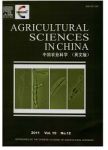Genetic and agronomic traits stability of marker-free transgenic wheat plants generated from Agrobacterium-mediated co-transformation in T2 and T3 generations
Genetic and agronomic traits stability of marker-free transgenic wheat plants generated from Agrobacterium-mediated co-transformation in T2 and T3 generations作者机构:Biotechnology Research InstituteChinese Academy of Agricultural SciencesBeijing 100081P.R.China Institute of Crop SciencesChinese Academy of Agricultural SciencesBeijing 100081P.R.China
出 版 物:《Journal of Integrative Agriculture》 (农业科学学报(英文版))
年 卷 期:2020年第19卷第1期
页 面:23-32页
核心收录:
基 金:the Ministry of Agriculture of China for the National Transgenic Research Program (2016ZX08010004) the Chinese Academy of Agricultural Sciences for the Agricultural Science and Technology Innovation Program (ASTIP-2060302-2-19)
主 题:wheat marker-free transgenic plants fluorescence in situ hybridization genetic stability
摘 要:Genetically modified wheat has not been commercially utilized in agriculture largely due to regulatory hurdles associated with traditional transformation methods. Development of marker-free transgenic wheat plants will help to facilitate biosafety evaluation and the eventual environmental release of transgenic wheat varieties. In this study, the marker-free transgenic wheat plants previously obtained by Agrobacterium-mediated co-transformation of double T-DNAs vector were identified by fluorescence in situ hybridization(FISH) in the T1 generation, and their genetic stability and agronomic traits were analyzed in T2 and T3 generations. FISH analysis indicated that the transgene often integrated into a position at the distal region of wheat chromosomes. Furthermore, we show that the GUS transgene was stably inherited in the marker-free transgenic plants in T1 to T3 generations. No significant differences in agronomic traits or grain characteristics were observed in T3 generation, with the exception of a small variation in spike length and grains per spike in a few lines. The selection marker of bar gene was not found in the transgenic plants through T1 to T3 generations. The results from this investigation lay a solid foundation for the potential application of the marker-free transgenic wheat plants achieved through the co-transformation of double T-DNAs vector by Agrobacterium in agriculture after biosafty evaluation.



